The humanitarian crisis following the earthquake in Haiti in 2010 was the starting point for a voluntary initiative to create maps to identify the level of damage and vulnerability by areas, and thus to coordinate emergency teams. Since then, the collaborative mapping project known as Hot OSM (OpenStreetMap) has played a key role in crisis situations and natural disasters.
Now, the organisation has evolved into a global network of volunteers who contribute their online mapping skills to help in crisis situations around the world. The initiative is an example of data-driven collaboration to solve societal problems, a theme we explore in this data.gob.es report.
Hot OSM works to accelerate data-driven collaboration with humanitarian and governmental organisations, as well as local communities and volunteers around the world, to provide accurate and detailed maps of areas affected by natural disasters or humanitarian crises. These maps are used to help coordinate emergency response, identify needs and plan for recovery.
In its work, Hot OSM prioritises collaboration and empowerment of local communities. The organisation works to ensure that people living in affected areas have a voice and power in the mapping process. This means that Hot OSM works closely with local communities to ensure that areas important to them are mapped. In this way, the needs of communities are considered when planning emergency response and recovery.
Hot OSM's educational work
In addition to its work in crisis situations, Hot OSM is dedicated to promoting access to free and open geospatial data, and works in collaboration with other organisations to build tools and technologies that enable communities around the world to harness the power of collaborative mapping.
Through its online platform, Hot OSM provides free access to a wide range of tools and resources to help volunteers learn and participate in collaborative mapping. The organisation also offers training for those interested in contributing to its work.
One example of a HOT project is the work the organisation carried out in the context of Ebola in West Africa. In 2014, an Ebola outbreak affected several West African countries, including Sierra Leone, Liberia and Guinea. The lack of accurate and detailed maps in these areas made it difficult to coordinate the emergency response.
In response to this need, HOT initiated a collaborative mapping project involving more than 3,000 volunteers worldwide. Volunteers used online tools to map Ebola-affected areas, including roads, villages and treatment centres.
This mapping allowed humanitarian workers to better coordinate the emergency response, identify high-risk areas and prioritize resource allocation. In addition, the project also helped local communities to better understand the situation and participate in the emergency response.
This case in West Africa is just one example of HOT's work around the world to assist in humanitarian crisis situations. The organisation has worked in a variety of contexts, including earthquakes, floods and armed conflict, and has helped provide accurate and detailed maps for emergency response in each of these contexts.
On the other hand, the platform is also involved in areas where there is no map coverage, such as in many African countries. In these areas, humanitarian aid projects are often very challenging in the early stages, as it is very difficult to quantify what population is living in an area and where they are located. Having the location of these people and showing access routes "puts them on the map" and allows them to gain access to resources.
In this article The evolution of humanitarian mapping within the OpenStreetMap community by Nature, we can see graphically some of the achievements of the platform.
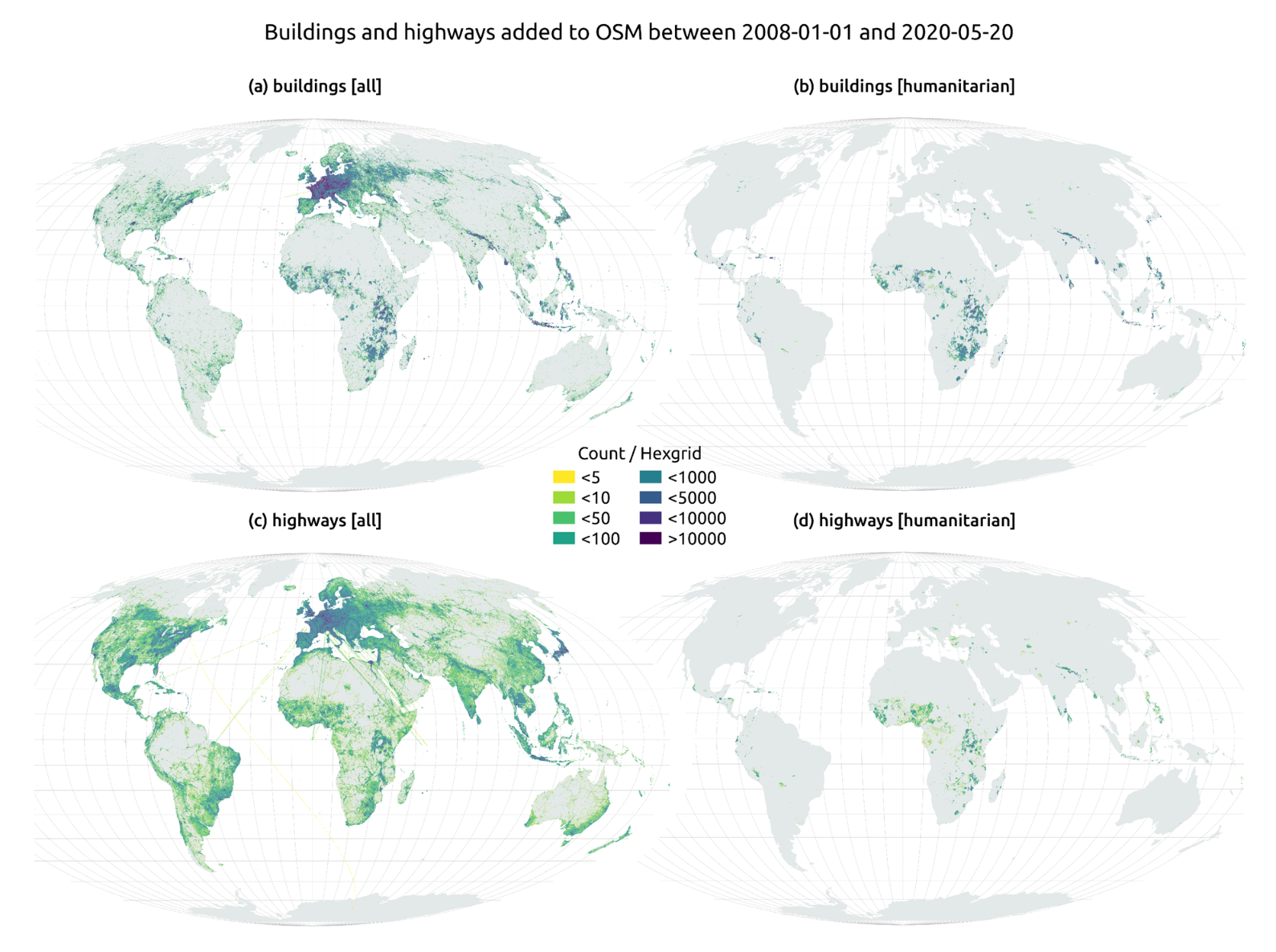
How to collaborate
It is easy to start collaborating with Hot OSM, just go to https://tasks.hotosm.org/explore and see the open projects that need collaboration.
This screen allows us a lot of options when searching for projects, selected by level of difficulty, organisation, location or interests among others.
To participate, simply click on the Register button.
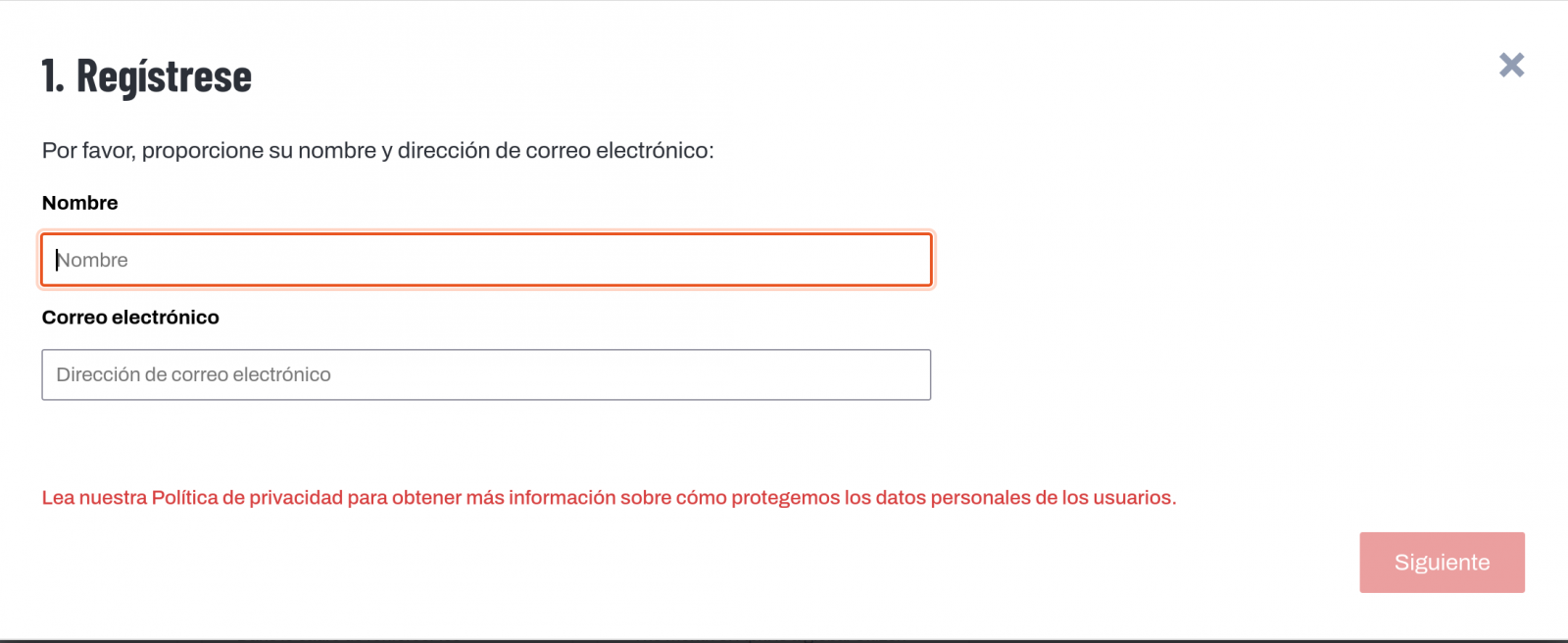
Give a name and an e-mail adress on the next screen:
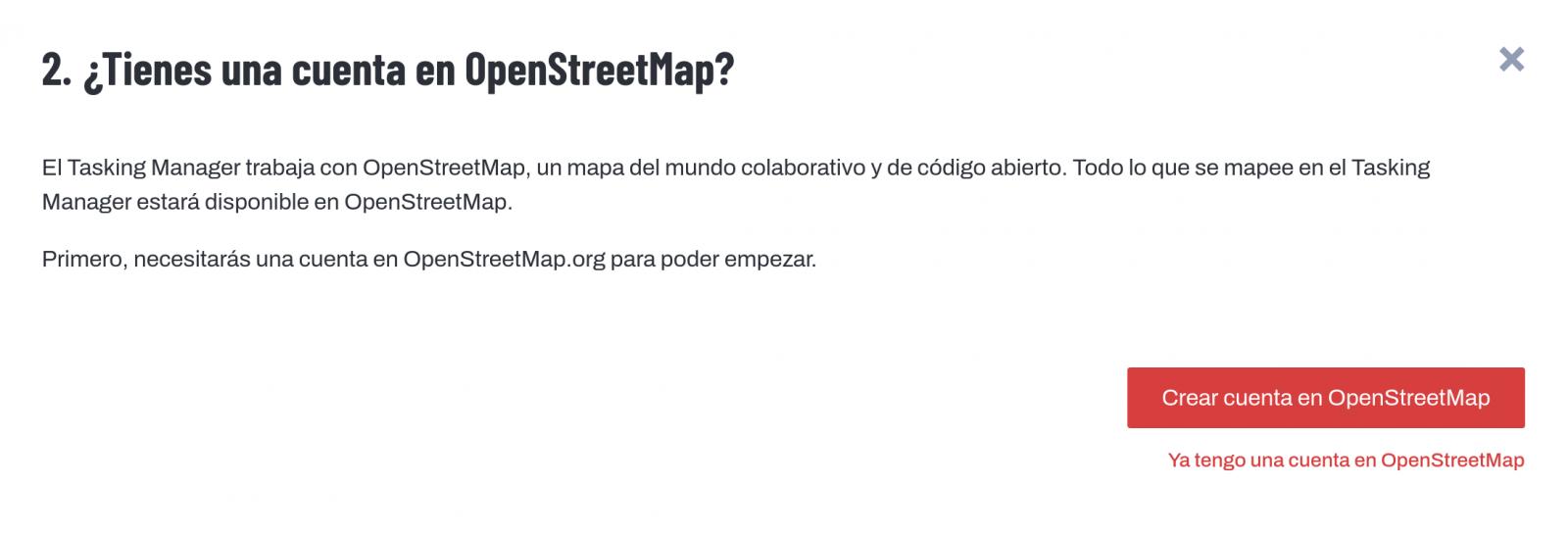
It will ask us if we have already created an account in Open Street Maps or if we want to create one.
If we want to see the process in more detail, this website makes it very easy.
Once the user has been created, on the learning page we find help on how to participate in the project.
It is important to note that the contributions of the volunteers are reviewed and validated and there is a second level of volunteers, the validators, who validate the work of the beginners. During the development of the tool, the HOT team has taken great care to make it a user-friendly application so as not to limit its use to people with computer skills.
In addition, organisations such as the Red Cross and the United Nations regularly organise mapathons to bring together groups of people for specific projects or to teach new volunteers how to use the tool. These meetings serve, above all, to remove the new users' fear of "breaking something" and to allow them to see how their voluntary work serves concrete purposes and helps other people.
Another of the project's great strengths is that it is based on free software and allows for its reuse. In the MissingMaps project's Github repository we can find the code and if we want to create a community based on the software, the Missing Maps organisation facilitates the process and gives visibility to our group.
In short, Hot OSM is a citizen science and data altruism project that contributes to bringing benefits to society through the development of collaborative maps that are very useful in emergency situations. This type of initiative is aligned with the European concept of data governance that seeks to encourage altruism to voluntarily facilitate the use of data for the common good.
Content by Santiago Mota, senior data scientist.
The contents and views reflected in this publication are the sole responsibility of the author.
Data are fundamental to solving the social and economic challenges we face today. It allows us to understand the causes behind a given situation and the factors that influence it, to estimate how it is evolving and to make informed decisions for change.
The problem is that solving such challenges often requires a combination of data from different sources:
- Data provided by the public sector
- Data from multiple private sector companies
- Citizen-generated data
But how can such collaboration be achieved? This is the question posed in the report "How to facilitate data collaboration to solve societal problems", written by Jose Luis Marín in the framework of the Aporta Initiative.
The report begins with a brief introduction outlining the current state of data openness in the public and private sectors, as well as in the citizenry. Then, it discusses the main barriers to data sharing by companies and citizens, the individual and collective benefits that can motivate these practices in the public interest, and the policies that can be put in place by public administrations to compensate and encourage collaboration.
Once the context is clear, it is time to look at some of the existing mechanisms for collaboration in data collection, sharing or processing to address a societal challenge. Although there are no systematised analyses of ideal forms of governance, four formulas have been identified for this report:
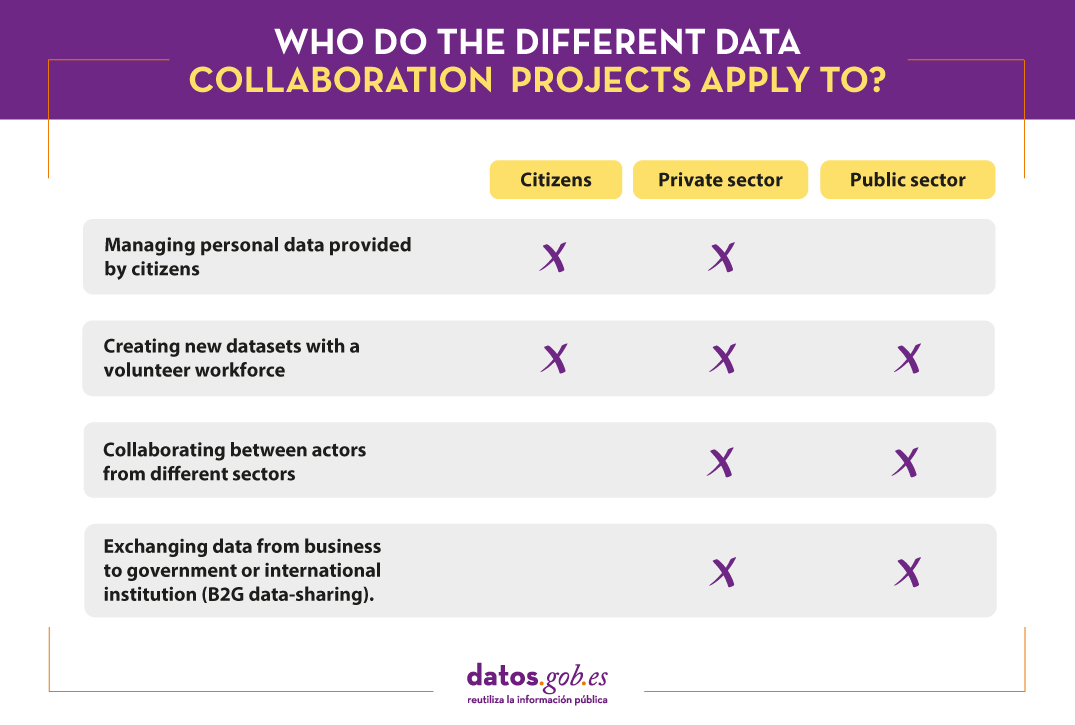
In order to illustrate and better understand each formula, the report includes multiple examples of international success stories, such as the Accelerating Medicines Partnership (AMP), which focuses on transforming the current model of developing new diagnostics and treatments, or the Open Apparel Registry (OAR), which aims to contribute to improving human rights and environmental conditions around factories.
The report concludes with a series of resources to help organisations collaborate successfully and reduce barriers, including collaboration networks, collaboration frameworks, courses and trainings.
Below, you can download the report, as well as access the complementary materials (executive summary, video-interview and summary presentation). The report is translated into English, but additional materials are available in Spanish version only.
After a period in which efforts were focused on releasing data, mainly from the public sector, in conditions in which it could be reused to create value in its different forms (economic, social, cultural, etc.), we are finding increasing activity around collaboration between organizations to solve big problems using data. There is not yet a consensus around these diverse initiatives, but we are seeing the popularization of a number of concepts among which there are many similarities and which seek to characterize a reality that has been identified as being of great importance for the development of the data strategies of governments and institutions.
For example, the European Commission has recently introduced, along with the concepts of data spaces and data intermediaries, the concept of "data altruism organisation recognised in the Union" in its proposed Data Governance Law. This figure, still to be developed, would be related to the mechanisms envisaged to regulate the altruistic transfer of data and would have the possibility of being registered as a voluntary mechanism to strengthen the confidence of users.
The 2025 Digital Spain plan, although it does not give them a specific name, foresees among its objectives in terms of Data Economy and Artificial Intelligence the creation of strong collaboration mechanisms between the public and private sectors, the public impulse to data sharing and the development of lighthouse projects to use both public and private data for the common good. All this among the different measures to make Spain a reference in the transformation towards a Data Economy.
Data management organizations
Although the term may be new, and has yet to be consolidated, "data altruism organizations" have existed in the public and private sectors and in the third sector for a long time. In the absence of a better name in English, in this article we will refer to "data institutions", as "organisations that steward data on behalf of others, often towards public, educational or charitable aims". This definition is the one proposed by the Open Data Institute (ODI), which is currently leading the most important efforts to characterize these types of organizations and establish a common framework for us to communicate about them.
In the definition, the term "organization" could be interpreted in different ways: foundation, association, institution, public body or similar, since there are multiple formulas that can be adopted according to countries and legal frameworks. On the other hand, in the definition the term "data management" refers to the activities that lead to collecting, maintaining and sharing data and, of course, to determining who has access to the data, how the data is accessed, for what purpose and for whose benefit. Therefore, data management organizations would be placed in the first of the three main activities that create value from raw data and that according to the ODI itself are ODI:
- Manage data: collect, maintain and share data, i.e., the activities of creating datasets, storing, curating or enriching them, and managing governance and access to them.
- Creating information from that data, in the form of products and services, analysis and discovery, or stories and visualizations. In this case we would enter the first layers of data analytics, that is exploratory, descriptive and diagnostic analytics of datasets.
- Deciding what to do, making decisions with information that supports the experience and one's own understanding of the context. In other words, what is characterized in other frameworks as the most complex and valuable phases of data analytics, i.e. predictive and prescriptive analytics.
Data collaborations
GovLab also defines the more well-known figure of "data collaboratives" as a set of new forms of collaboration, beyond the classic public-private partnership model, in which participants from different sectors, companies, research institutions or government agencies, share their data to solve problems of public interest. GovLab also aims to accelerate the creation and use of "data collaborations" in order to harness the potential of data to improve people's lives. An example of such collaborations could be Global Fishing Watch in which Google, Oceana and Sky Truth join data, efforts and resources with the goal of stopping illegal fishing by tracking the movement of more than 35,000 boats.
Some models of collaboration and governance
Regardless of the different nuances in the definitions, and without wishing to be exhaustive, we can identify some patterns in the way in which the different collaboration formulas interact with each other, with people and their rights over data. These patterns do not refer to the business model, but rather to the different ways in which data governance is established:
- Individuals contribute their data to the organization and, on a case-by-case basis, individuals can choose to allow third parties to access that data. An example of this model is HealthBank, which allows individuals to upload their medical records to share them with doctors or "loved ones", or the information banks in Japan that aim to allow users themselves to monetize their data.
- Individuals contribute their data to the organization and, on a case-by-case basis, individuals can choose whether that data is shared with third parties as part of aggregated datasets. Another variant is where decisions about which third parties can access are made collectively. A good example of the latter case would be The Good Data, a kind of cooperative that aims to sell web browsing data generated by its users where they can also participate in deciding the rules.
- The organization provides a platform to collect or create new datasets with the voluntary work of people. In this category we find some well-established platforms such as OpenStreetMap, which collaboratively maintains free maps of the world, or Wikipedia.
- The organization combines or links data from multiple sources and provides information and other services to those who have contributed data. In the maritime sector, HiLo aggregates data generated by about 3,500 ships worldwide to generate risk and safety analyses related to maritime accidents.
- The organization acts as a custodian of data held by other organizations. For example, Harvard University's Social Science One seeks to liberate data generated by Facebook for the public good by making them available for new social science research.
Although the boundaries between the different approaches are in many cases unclear and some of the models may overlap with each other, what seems clear is that new formulas are being explored to allow data to be shared in more flexible and innovative ways, respecting individual autonomy and generating wider societal benefits. Which is excellent news at a time when we cannot forget that the world's largest companies by market capitalization are technology companies offering services based on the collection, use and sharing of data. Thanks to data management organizations, it is possible to move towards a future in which data contributes more decisively to solving humanity's great challenges and not just to creating private value.
Content prepared by Jose Luis Marín, Senior Consultant in Data, Strategy, Innovation & Digitalization.
The contents and views reflected in this publication are the sole responsibility of the author.
On too many occasions, open data initiatives are born in governments as purely technical projects whose purpose is simply creating a data catalog, when, in reality, they should be seen as collaborative transformation projects that take place within complex and variable environments, in which the ultimate purpose is not entirely clear and the coordinating entities - the public administration in this case - do not have all the resources to generate the necessary change by themselves.
In fact, in order to exploit its full potential, open data must be able to count on a healthy and balanced ecosystem that sustains and nourish it. The data will be no more than the common platform on which this ecosystem supports and which provides the raw material necessary for it to nourish and evolve.
Therefore, one of the keys to the success (or failure) of any open data initiative will be its ability to create and evolve an active community of users around published data, establishing permanent communication and collaboration mechanisms that enable processes of feedback and co-creation throughout the process.
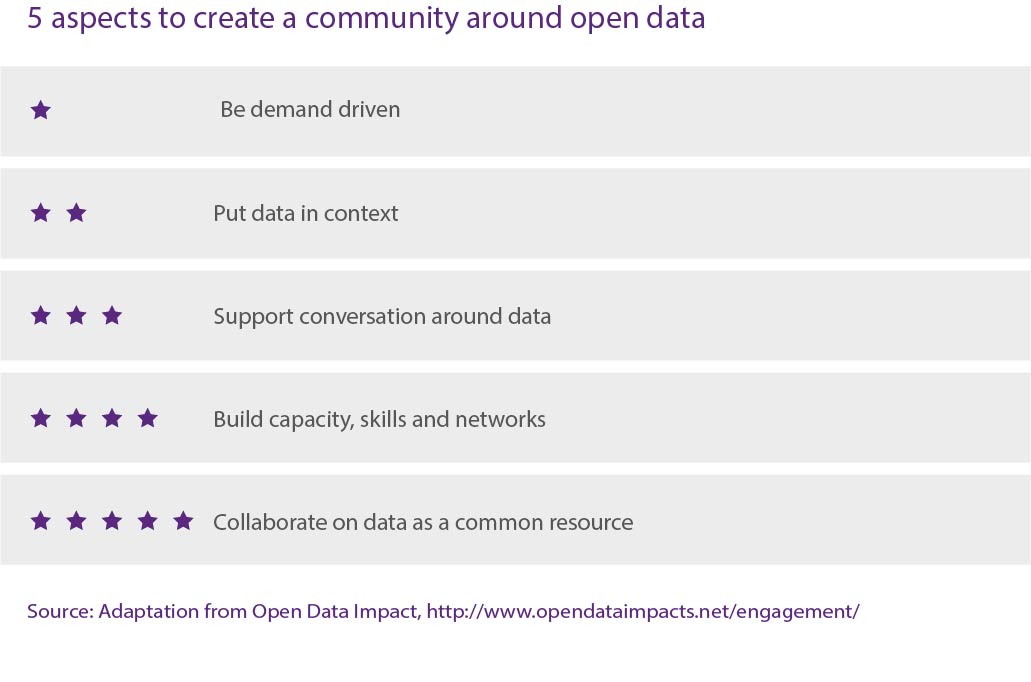
It is also important that these processes are established for the multiple actors that should be part of that ecosystem:
-
Public sector: including all levels of the administration and whose role will be to provide political support, ensure long-term sustainability, provide strategic direction at the highest level, guide implementation, create standards, set the agenda or give support.
-
Non-governmental organizations: focused mainly on using data as a tool for their different activities, raising awareness about the real value behind data, monitoring relevant policies and demanding greater data availability and participation guarantees.
-
Civic hackers: they will use their most technical knowledge to transform the data and make sense for the different audiences.
-
Media: whose role is to use data to inform, do investigative journalism and tell stories through data that reaches citizens more directly.
-
University and Research institutions: using data not only to develop theoretical concepts and frameworks, but also applied research to create new products and services through data and innovation.
-
Private sector: generating value and business based on data, providing the necessary data infrastructures, collaborating to facilitate opening processes and contributing their own data to enrich the ecosystem.
And given that the key is in the ecosystem, how will we then build a successful ecosystem? For example, we can look at the ten lessons shared by pioneers of the Internet, the largest and most successful social ecosystem to date thanks to collaboration:
- Let everyone play: attract new resources and generate new ideas.
- Play nice: a common mistake will be to reduce potential participation by putting serious barriers to entry to avoid low quality contributions, vandalism, etc.
- Talk about what you are doing while you are doing it: improve understanding and participation, avoid overlaps and build trust.
- Use multiple channels of communication: do not focus solely on the Web.
- Give it away: do not reserve what you know and learn.
- Reach for the edges: you will need that vision when the most complicated problems appear.
- Make it work, then make it better: you will need the participation of everyone with different interests and incentives.
- Design for participation: divide the work into manageable tasks that are easy to do and invite to get involved.
- Increase network impact: a community model based on a network of nodes that interact with each other will lead to exponential growth.
- Build platforms: help people and organizations coordinate so they are more productive together.
“If you focus on avoiding people to make wrong things (with data), you will also avoid them to make right ones", – Jimmy Wales, Wikipedia cofounder.